
An amusement park is a park that features various attractions, such as rides and games, as well as other events for entertainment purposes. A theme park is a type of amusement park that bases its structures and attractions around a central theme, often featuring multiple areas with different themes. Unlike temporary and mobile funfairs and carnivals, amusement parks are stationary and built for long-lasting operation. They are more elaborate than city parks and playgrounds, usually providing attractions that cater to a variety of age groups. While amusement parks often contain themed areas, theme parks place a heavier focus with more intricately-designed themes that revolve around a particular subject or group of subjects.

LaMarcus Adna Thompson was an American inventor and businessman most famous for developing a variety of gravity rides and roller coasters.

The generic roller coaster vertical loop, where a section of track causes the riders to complete a 360 degree turn, is the most basic of roller coaster inversions. At the top of the loop, riders are completely inverted.
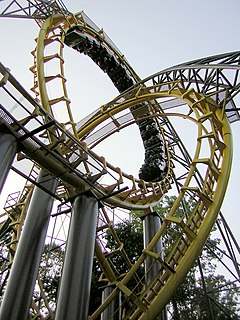
A roller coaster inversion is a roller coaster element in which the track turns riders upside-down and then returns them to an upright position. Early forms of inversions were circular in nature and date back to 1848 on the Centrifugal railway in Paris. These vertical loops produced massive g-force that was often dangerous to riders. As a result, the element eventually became non-existent with the last rides to feature the looping inversions being dismantled during the Great Depression. In 1975, designers from Arrow Development created the corkscrew, reviving interest in the inversion during the modern age of steel roller coasters. Elements have since evolved from simple corkscrews and vertical loops to more complex inversions such as Immelmann loops and cobra rolls. The Smiler at Alton Towers holds the world record for the number of inversions on a roller coaster with 14.
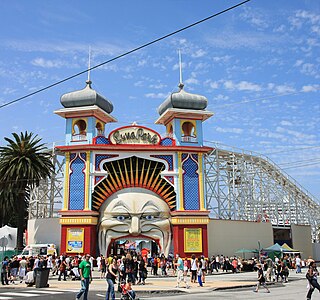
Luna Park Melbourne is a historic amusement park located on the foreshore of Port Phillip Bay in St Kilda, Melbourne, Victoria. It opened on 13 December 1912, with a formal opening a week later, and has been operating almost continuously ever since.

The Cyclone, also the Coney Island Cyclone, is a wooden roller coaster at Luna Park in Coney Island, Brooklyn, New York City. Designed by Vernon Keenan, it opened to the public on June 26, 1927. The roller coaster is on a plot of land at the intersection of Surf Avenue and West 10th Street. The Cyclone reaches a maximum speed of 60 miles per hour (97 km/h) and has a total track length of 2,640 feet (800 m), with a maximum height of 85 feet (26 m).

Olentangy Park (1880–1937) was an amusement park in Clintonville, Columbus, Ohio.
Loop-the-Loop is a vertical loop or 360 degree turn in a roller coaster track, derived from a similar aerobatic maneuver.
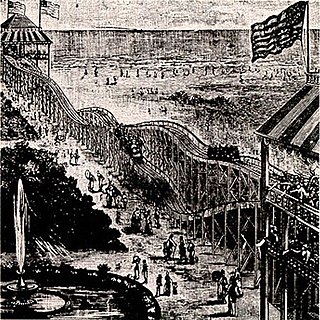
The original Switchback Railway was the first roller coaster at Coney Island in Brooklyn, New York City, and one of the earliest designed for amusement in the United States. The 1885 patent states the invention relates to the gravity double track switchback railway, which had predicated the inclined plane railway, patented in 1878 by Richard Knudsen. Coney Island's version was designed by LaMarcus Adna Thompson in 1881 and constructed in 1884. It appears Thompson based his design, at least in part, on the Mauch Chunk Switchback Railway which was a coal-mining train that had started carrying passengers as a thrill ride in 1827.
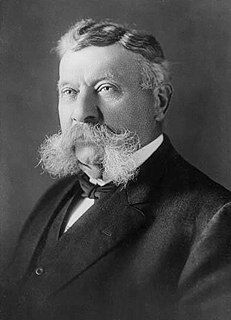
Charles I. D. Looff was a German master carver and builder of hand-carved carousels and amusement rides, who immigrated to the United States of America in 1870. Looff built the first carousel at Coney Island in 1876. During his lifetime, he built over 40 carousels, several amusements parks, numerous roller coasters and Ferris wheels, and built California's famous Santa Monica Pier. He became famous for creating the unique Coney Island style of carousel carving.

Sea Lion Park was a 16-acre (65,000 m2) amusement park started in 1895 on Coney Island by Paul Boyton. He fenced the property and charged admission, the park becoming the first enclosed and permanent amusement park in North America. Up until the establishment of this park, amusement areas around the country consisted of pay-as-you-go concessions. In 1903, Sea Lion Park was replaced by Luna Park.
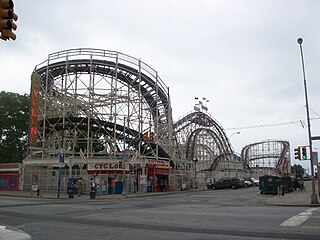
Roller coaster amusement rides have origins back to ice slides constructed in 18th-century Russia. Early technology featured sleds or wheeled carts that were sent down hills of snow reinforced by wooden supports. The technology evolved in the 19th century to feature railroad track using wheeled cars that were securely locked to the track. Newer innovations emerged in the early 20th century with side friction and underfriction technologies to allow for greater speeds and sharper turns. By the mid-to-late 20th century, these elements intensified with the introduction of steel roller coaster designs and the ability to invert riders.

Luna Park is an amusement park in Coney Island, Brooklyn, New York City. It opened on May 29, 2010, at the site of Astroland, an amusement park that had been in operation from 1962 to 2008, and Dreamland, which operated at the same site for the 2009 season. It was named after the original 1903 Luna Park which operated until 1944 on a site just north of the current park's 1000 Surf Avenue location.

Centrifugal Railway was the name of a number of early looping roller coasters that were built in Western Europe in the middle of the 19th century. These rides were very similar in their basic design to many modern day shuttle roller coasters, but with only one lift hill and no launch. A single roller coaster car would ascend to the peak on the coaster before descending rapidly down the same hill and then passing through the central loop with enough speed and centrifugal force to remain on the track at the top of the loop. The size of these centrifugal railways differed; some were purported to have vertical loops of a mere 6.5 feet (2.0 m), while others were estimated to be 40 feet (12 m).

Flip Flap Railway was the name of a looping wooden roller coaster which operated for a number of years at Paul Boyton's Sea Lion Park on Coney Island in Brooklyn, New York. The coaster, which opened in 1895, was the first looping roller coaster to operate in North America. It was also notable for its engineering as well as the extreme G-forces that this engineering inflicted on riders.
Lina Beecher was an American inventor and roller coaster engineer. Beecher is best known for building the first looping roller coaster in North America, which was known as the Flip Flap Railway, and a later looping roller coaster known as Loop the Loop. He is also known for designing a number of other inventions and patents with a variety of applications.
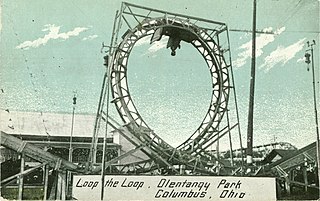
Loop the Loop was an early looping steel roller coaster which operated at Olentangy Park in Columbus, Ohio during the first decade of the 1900s. It was one of the first looping roller coasters to operate in North America, and it was designed and built by noted inventor Lina Beecher.

Loop the Loop was a dual-tracked steel roller coaster that operated on Coney Island in Brooklyn, New York, from 1901 to 1910. The coaster was one of the first looping roller coasters in North America.

Thunderbolt is a steel roller coaster at Luna Park in Coney Island, Brooklyn, New York City. It is located near Surf Avenue and West 15th Street, on the Riegelmann Boardwalk next to the B&B Carousell.

















